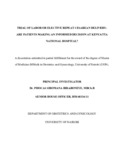Trial of Labor or Elective Repeat Cesarean Delivery: Are Patients Making an Informed Decision at Kenyatta National Hospital?

View/
Date
2015Author
Biraboneye, Phocas, S
Type
ThesisLanguage
enMetadata
Show full item recordAbstract
Background With a low risk uterine rupture of 0.07% and high success rate of about 80%, trial of labor is a reasonable and safe option for most women after one previous cesarean delivery. As such physicians have both legal and ethical responsibility to provide adequate information to the patients in order to make appropriate informed decisions regarding the mode of delivery.
However, current studies suggest that the proportion of women attempting trial of labor after previous caesarean delivery has been declining in many countries. In addition, other recent studies have shown that women with prior cesarean delivery appear to know little regarding their mode of delivery and that healthcare providers‟ recommendations as well as their preferences exert a strong influence on patient‟s decision whether or not to pursue TOLAC.
In Kenya, it is unclear whether women who would be offered trial of labor after cesarean delivery (TOLAC) or elective repeat cesarean delivery (ERCD) do that based on clear understanding of risks and benefits of both mode of delivery.
Objective This study aimed at determining whether patients with one previous cesarean delivery are making an informed decision on preferred mode of delivery.
Methods A five-month cross sectional study targeting women with one previous cesarean delivery attending ANC at KNH was performed from September 2013 to January 2014. Data was collected from both the patients‟ records and interview using a structured questionnaire. Univariate and multivariate analysis was done using STATA 11.0.
Results Two hundred and two women with mean (SD) age of 30.2 ± 4.7 years were sampled; (136) 67.2% of them chose ERCD while (66) 32.8% chose TOLAC. It was found that only (61) 30.6% (C.I: 24.4 to 37.6%) of the patients were making an informed decision. Few patients (65) 32.2% knew that the chance of successful TOLAC were high (60-80%) and most of them 97 (48%) were not aware of the chances for a successful TOLAC; More than half of the patients 109 (53.9%) were unaware of the risk of uterine rupture after one previous caesarean delivery and only few patients 64 (31.7%) knew that the risk of uterine rupture in TOLAC were low (< 1%). The majority of the patients 112 (55.4 %) did not know that the indications for previous cesarean delivery are an important factor in determining the chance of a successful VBAC. Few patients 23 (11.4%) for ERCD signed the consent form while none of the patients for TOLAC signed any consent form.
The patient preferred mode of delivery before attending ANC at KNH was significantly associated with the chosen mode of delivery after (p=0.001). The knowledge of the patients regarding the risk of uterine rupture and overall chances of success of TOLAC was found to be associated with the chosen mode of delivery (p=0.001).The patients‟ mode of delivery was significantly associated with the preference of the counseling doctor (p=0.001) and their qualification (p=0.020).
xv
Conclusion The majority of the patients 141 (69.4%) demonstrated an overall lack of information on both modes of delivery while doctor‟s preference affected the patient‟s decision.
Recommendation There is need to develop clear standard protocols and checklists for information to be disseminated to all patients with previous cesarean delivery in subsequent pregnancies in Kenya.
Rights
CC0 1.0 UniversalUsage Rights
http://creativecommons.org/publicdomain/zero/1.0/Collections
The following license files are associated with this item:

